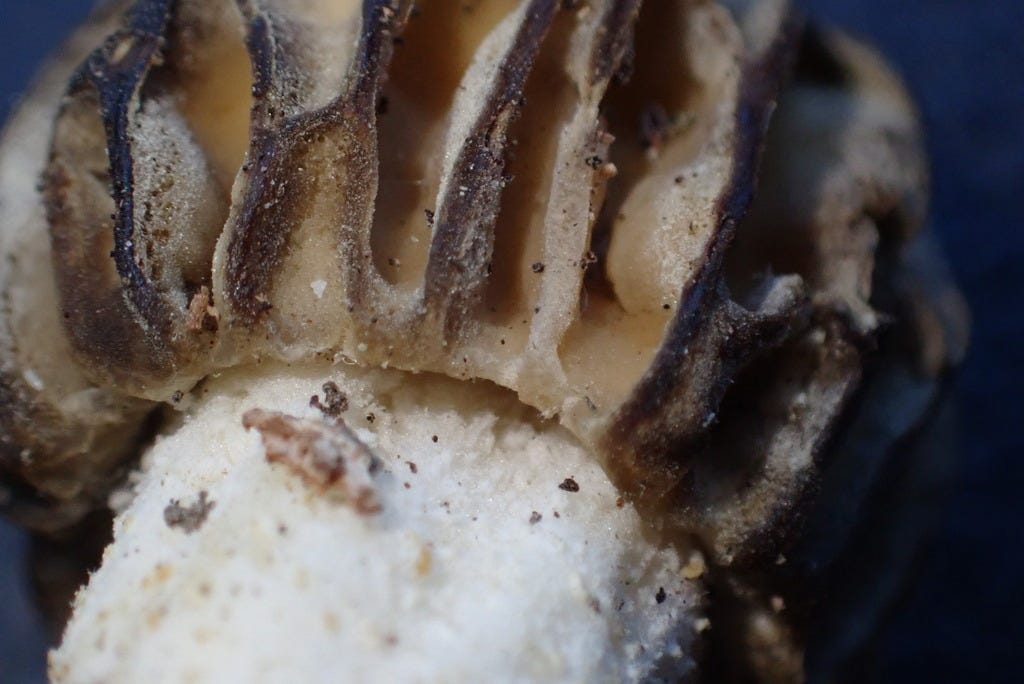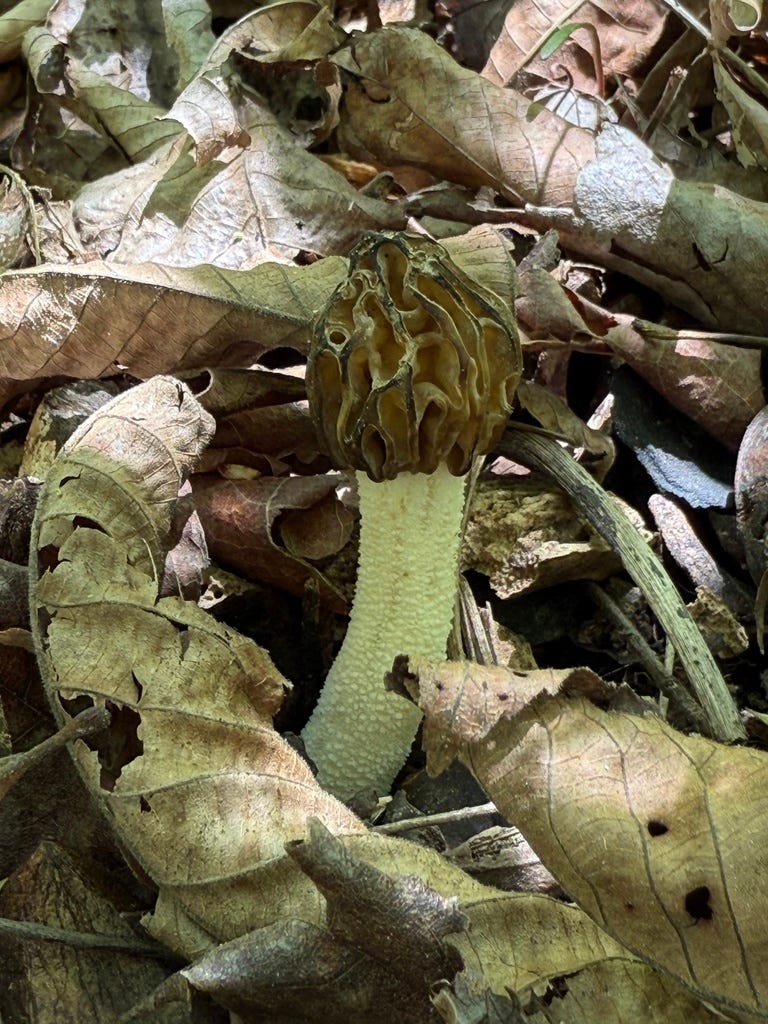Good evening, friends,
This week’s mushroom is the half-free morel (Morchella punctipes) which we found last weekend at Morelfest. This is the brief three to four weeks of the year where folks are frantically combing through the woods, looking for these coveted edible mushrooms. While the half-free morel is edible, they’re a little on the smaller side so they don’t typically make for the most fruitful foraging. There are, however, ecological implications to ponder and we’ll also touch a little more on the potential pros and cons of eating these and other morels.
Fun Facts
While half-free morel is the more formal common name, the mushroom also masquerades under the moniker of “peckerhead”. In this textbook double entendre, the mushroom does look rather phallic but it was also first described by the New York State Mycologist Charles Peck in 1903. Which entendre was originally intended has been lost to history.
Interestingly, the etymology of Morchella is not from Greek nor Latin, at least not directly, but instead is traced back to the old Germanic word morchel. Morchel seems to have referred to the morel mushroom and mushrooms in general. Punctipes, the species epithet, was given to the mushroom by Peck and means “dotted foot” which refers to the mushroom’s bumpy stem (a “punctate stipe” in mycological terms).
Morels are typically highly coveted for culinary purposes, but these peckerheads don’t pack much of a punch as far as palatability. You’d need dozens to constitute a meal as they only range up to five centimeters tall and they shrink even more when you cook them. Most people think it’s the cold that shrinks peckerheads, but not in this instance. Folks… a common name like this comes across the dash maybe once a year, my hand was forced.
Earlier today, I hopped on WIOX radio and talked with my friend and Catskill Fungi cohort, Erwin, about morel habitat and we also touched on some of the not so glamorous aspects of eating morels (or their look-a-likes). Dr. Cathy Cripps gave a whole presentation on the morel poisonings in Montana that made the news a couple years ago, and more recently there was an article in the Atlantic suggesting false morels (Gyromitra) could be linked to an ALS cluster outbreak in France. That said, people eat dozens of them every spring with no ill-effects.
The moral of the story is to thoroughly cook your morels, and any mushrooms for that matter, before eating them. Boiling the mushrooms before sautéing them would help further break down or remove potentially harmful compounds.

Ecology
The mushroom’s ecological services aren’t fully understood and it’s unclear whether the fungus is saprobic (a decomposer), mycorrhizal (a tree symbiont), or both. I found a handful of Morchella diminutiva equally distributed around the same tree which gave the appearance of a mycorrhizal relationship, but there was only one Morchella punctipes so it’s more difficult to hypothesize what was going on in soil with this fungus.
The fact that there were two different species of morels growing around the same tree, and no morels around the dozens of hickories I checked in the same area, certainly is peculiar. Could be a coincidence, could be more than a coincidence.

There are two species of half-free morels in North America (at this point in time). East of the Rockies you will find our Morchella punctipes, growing both in the woods and occasionally in mulched, urban areas. West of the Rockies, there’s Morchella populiphila which grows with cottonwoods (Populus). They all used to be called Morchella semilibera which is now exclusively the European species.
There’s also another mushroom that looks similar but isn’t a “true morel”: Verpa bohemica. This mushroom’s cap is totally free, not half-free, and has a pithy inside rather than the hollow stipe of true morels (Morchella).
Enjoy the remaining minutes in Cinco de Mayo and if you’re reading this Tuesday, have a great Seis de Mayo,
Aubrey
References:
Kuo, M. (2024, April). Morchella punctipes. Retrieved from the MushroomExpert.Com Web site: http://www.mushroomexpert.com/morchella_punctipes.html.
Kuo M, Dewsbury DR, O'Donnell K, Carter MC, Rehner SA, Moore JD, Moncalvo JM, Canfield SA, Stephenson SL, Methven AS, Volk TJ. Taxonomic revision of true morels (Morchella) in Canada and the United States. Mycologia. 2012 Sep-Oct;104(5):1159-77. doi: 10.3852/11-375. Epub 2012 Apr 11. PMID: 22495449.
https://www.madaboutmushrooms.com/mad_about_mushrooms/verpa_101/








COTTONWOODS well SHIT I should have read this AGES ago!!!! Not me lurking under every cottonwood I know about, now.